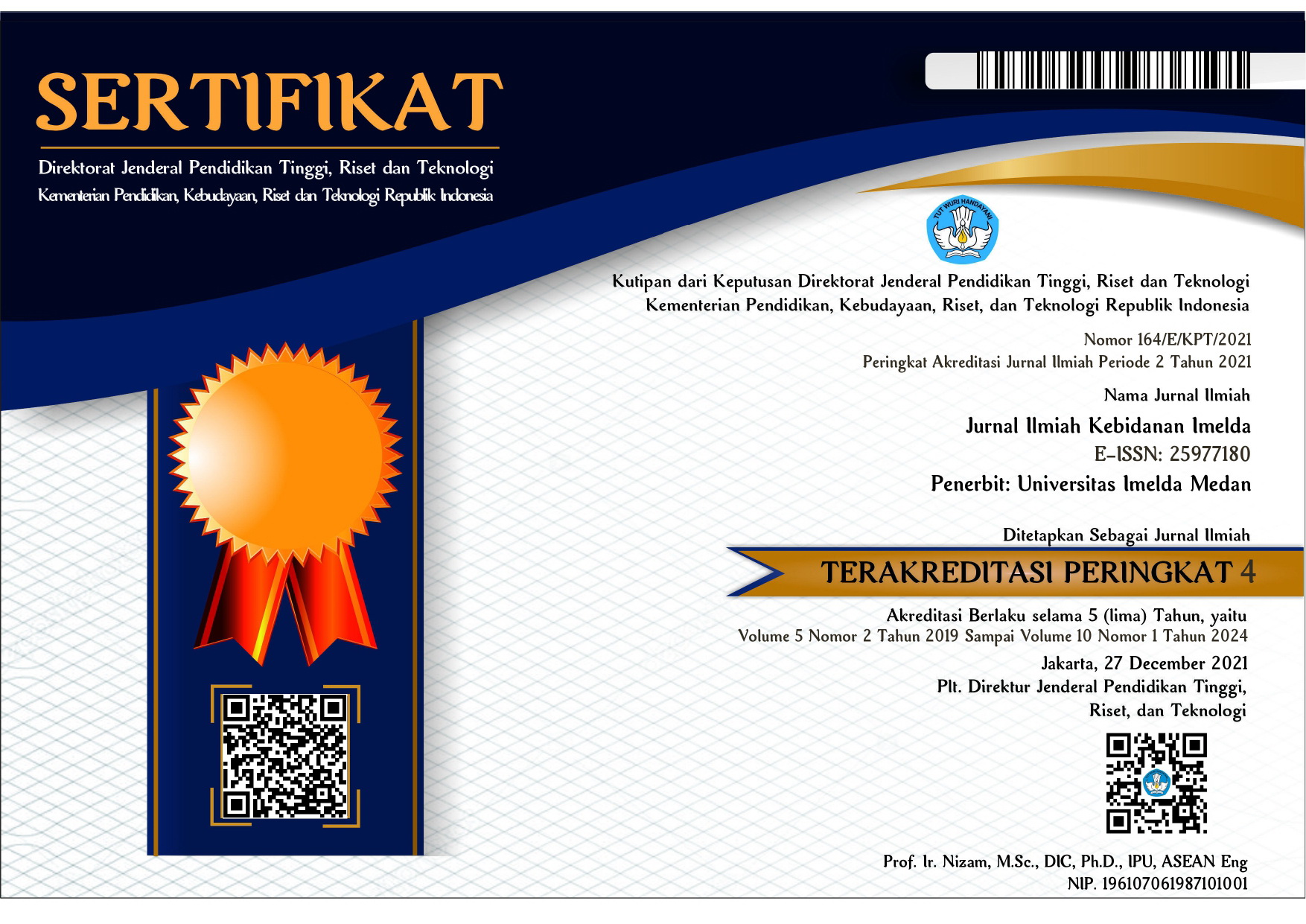STUDI KASUS: ASUHAN KEBIDANAN PASKA PERSALINAN DENGAN RETENSIO URINE
DOI:
https://doi.org/10.52943/jikebi.v10i1.1508Keywords:
Retention Urine, Midwifery Care, PostpartumAbstract
Postpartum urinary retention is defined as the absence of spontaneous urination or the inability to urinate spontaneously starting 6 hours after vaginal delivery, and the inability to urinate spontaneously 6 hours after catheter removal during delivery with the following actions:caesarean section. This complaint can be caused by hormonal changes, changes in the contractile response of the bladder, innervation trauma that occurs in the bladder, and several other risk factors, namely perineal laceration or episiotomy, delivery with the help of tools, duration of the first stage of labor.>12 hours, duration of second stage of labor>1 hour in multiparas, and birth weight of the baby>3800 grams. The aim of this research is to provide midwifery care to mothers after giving birth who complain of not being able to urinate since 3 days after giving birth. Care is carried out by paying attention to midwifery management steps according to Helen Varney. The research was carried out from 27 March to 09 April 2023 at Gunung Jati Hospital, Cirebon City, using a case study research method and the research subject was Mrs W P1 A0 aged 23 years. Primary and secondary data collection. Primary data was obtained through interviews, observation and physical examination, while secondary data was obtained through documentation and literature studies. The analysis used is descriptive and exploratory through studying data from research subjects. The results of the care were discussed by taking into account similar previous research and a review of relevant literature so that it could be concluded that there was no gap between theory and the care given to Mrs W
References
I. Anugerah, W. A. Iswari, T. U. Pardede, and F. Darus, “Tatalaksana Retensio Urin Pasca-Persalinan,” vol. 44, no. 8, pp. 531–536, 2017.
A. R. Zahrania and R. M. Sholihin, “Urinary retention,” in Proceeding of The 15th Continuing Medical Education, 2022, pp. 418–427.
Tiberon, Carbonnel, Vidart, B. Halima, Deffieux, and Ayoubi, “Risk factors and management of persistent postpartum urinary retention,” J Gynecol Obs. Hum Reprod, vol. 47, no. 9, 2018, doi: 10.1016/j.jogoh.2018.08.002.
S.-K. Yip, D. Sahota, M.-W. Pang, and A. Chang, “Postpartum urinary retention,” Acta Obs. Gynecol Scand, vol. 10, pp. 881–891, 2004, doi: 10.1111/j.0001-6349.2004.00460.x.
F. E. M. Mulder, R. A. Hakvoort, M. A. Schoffelmeer, J. Limpens, J. A. M. Van der Post, and J. P. W. R. Roovers, “Postpartum urinary retention: a systematic review of adverse effects and management,” Int. Urogynecol. J., vol. 25, no. 12, pp. 1605–1612, 2014, doi: 10.1007/s00192-014-2418-6.
I. Kawasoe and Y. Kataoka, “Prevalence and risk factors for postpartum urinary retention after vaginal delivery in Japan: A case-control study.,” Jpn J Nurs Sci, vol. 17, no. 2, 2020, doi: 10.1111/jjns.12293.
H. E. Utami, Suparni, dan W. Ersila, “Waktu Pertama Buang Air Kecil (BAK) Pada Ibu Postpartum Yang Dilakukan Bladder Training,” J. Ilm. Kesehat., vol. 6, no. 1, 2014.
N. Hidayati, Widyawati, dan E. D. Hapsari, “Faktor Risiko Retensi Urin Pasca-Persalinan Pervaginam: Case-Control Study,” no. 2008, pp. 140–143, 2020.
S. Djusad, “Manajemen Retensio Urin Pasca Persalinan Pervaginam,” eJournal Kedokt. Indones., vol. 8, no. 1, pp. 2–8, 2020, doi: 10.23886/ejki.8.11690.
D. Mulyana, Metode Penelitian Kualitatif. Bandung: PT Remaja Rosdakarya, 2018.
J. M. Simarmata, S. Suhaimi, M. Zannah, A. M. Syara, R. Ginting, dan Maisyaroh, “Pengaruh Bladder Training terhadap Percepatan Pengeluaran Urine bagi Wanita setelah Melahirkan secara Operasi Caesar dengan Retensi Urine di RS Grandmed Lubuk Pakam Kabupaten Deli Serdang Tahun 2019,” J. Keperawatan dan Fisioter., vol. 3, no. 1, pp. 96–104, 2020.
S. Wahyuningsih, Metode penelitian studi kasus: Konsep, teori pendekatan Psikologi Komunikasi, dan contoh penelitiannya, 1st ed. Madura: Madura: UTM PRESS, 2013.
Rosdianah, Nahira, Rismawati, dan Nurqalbi SR, Buku Ajar Kegawatdaruratan Maternal Dan Neonatal. 2019.
N. D. Septiani, H. Hariyono, dan I. Rosyidah, “Hubungan Pesalinan Kala II Lama dengan Kejadian Retensio Urine,” J. Kebidanan, vol. 11, no. 1, pp. 1–10, 2021, doi: 10.35874/jib.v11i1.849.
G. S. Napoe, N. N. Adjei, A. C. Cooper, C. A. Raker, and N. B. Korbly, “Postpartum urinary retention: a survey of obstetrics and gynaecology residents in the United States,” J. Obstet. Gynaecol. (Lahore)., vol. 40, no. 8, pp. 1118–1121, Nov. 2020, doi: 10.1080/01443615.2019.1706159.
R. Noviyantina, “Hubungan Episiotomi, Ruptur Perineum Dan Jenis Persalinan Dengan Kejadian Retensio Urin Post Partum Di RSUD Dr. H. Soemarno Sosroatmodjo Kuala Kapuas Tahun 2015-2016,” STIKes Sari Mulia Banjarmasin, 2017.
H. P. Wahyuningsih, Bahan Ajar Kebidanan Asuhan Kebidanan Nifas dan Menyusui, vol. 1, no. 1. Jakarta: Pusdik SDM Kesehatan, 2018.
A. Sa, idah, A. Athiroh, B. Andriyani, D. Afifah, E. Agustina, dan E. Nisa’, “Pengaruh Bladder Training Terhadap Percepatan Pengeluaran Urine Pada Pasien Retensio Urine Post Partum,” Universitas Dr. Seoebandi, Jember, 2023.
RSUD Gunung Jati, “SOP Penatalaksanaan Retensio Urine Pada Ibu Nifas,” Cirebon, 2020.










